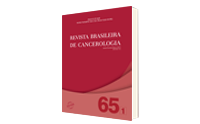Phase Angle and Nutritional Status in Individuals with Advanced Cancer in Palliative Care
DOI:
https://doi.org/10.32635/2176-9745.RBC.2019v65n1.272Keywords:
Neoplasms, Electric Impedance, Body Composition, Nutritional StatusAbstract
Introduction: Phase angle (PA) may be correlated with nutritional status in individuals with cancer. Objective: To investigate the correlation between PA and nutritional status in patients with advanced cancer. Method: Cross-sectional study with individuals of both sexes, aged >20 years, in their first care in the palliative care unit of the National Cancer Institute José Alencar Gomes da Silva (INCA). The PA was evaluated through bioelectrical impedance, being considered with low the values <percentile 5 (P5). The nutritional status was evaluated by the Patient-Generated Subjective Global Assessment (PG-SGA) Short Form, albumin, body mass index (BMI) and calf circumference (CC). The chi-square test and the Spearman correlation were used. The level of statistical significance adopted was 5%. Results: A total of 94 subjects were evaluated, with a median age of 66 (57; 74) years, female predominance (51.1%) and nutritional risk (85.1%). About one-third had low functional capacity (37.2%) and PA <P5 (36.2%). Nutritional risk was more prevalent in individuals with lower PA values. Body weight, CC and serum albumin levels showed a positive correlation with PA; while the total PG-SGA score, as well as most of its domains, correlated negatively. Only the BMI did not present statistical significance when evaluated in relation to PA. Conclusion: PA correlated with nutritional status;greater the value of PA, the better the nutritional status in patients with advanced cancer in palliative care.









